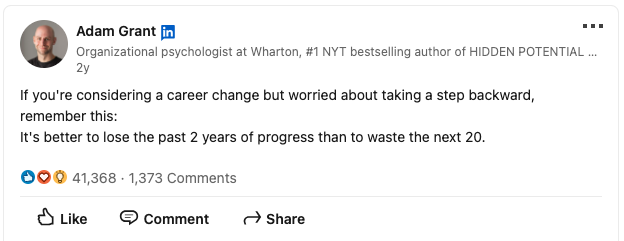Stepping back to succeed
Let’s say you’ve been cruising down your river and suddenly you encounter an obstacle. There’s a big old boulder sitting right in the middle of your path, and it came up so fast your canoe is now nudging right into it.
Would you try to push through the obstinate stone? Or would you back up and find another route forward?

When we think about it this way, it’s obvious that we’re better off backing up. But when we’re committed to the career ladder approach, taking a step back is seen as a loss. We worry about how it will look on our resume for future employers. We blame ourselves for not pushing ahead, even though there may be factors outside our control, or maybe we’re just not interested in the role on the next ladder rung.
I’m here today to tell you that backing up to move forward is not only necessary at times, it’s a key strategy to success. Just ask Steph Curry and Steve Martin.
As organizational psychologist Adam Grant describes in this interview about his book Hidden Potential, the NBA’s revolutionary point guard had to completely rehaul his shooting technique before he could claim the record for most three-pointers. And before Martin became a comedy superstar, he had to learn how to write killer one-liners instead of copying other comedians and improvising.
It’s tough to leave behind the progress we’ve made. When we’re focused on short-term losses, it’s hard to see what we could gain in the long run.

Instead of approaching our careers like a learning curve, steadily climbing ever upward, it’s more helpful to consider the advantages of “the learning pit,” where we first plunge into confusion before arriving at a eureka moment, as described by Miranda Green at the Financial Times:
Want full access to the Career River framework? Become a Navigator and receive this and other resources: